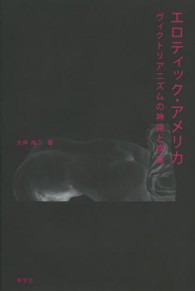- ホーム
- > 洋書
- > 英文書
- > Architecture
Full Description
This volume examines the pivotal role of movement, visibility, and experience within Pompeian houses as a major factor determining house form; the use of space; and the manner, meaning, and modalities of domestic daily life, through the application of GIS-based analysis.
Through close consideration of ancient literature, detailed explanations of methodology, and exploration of results, Michael Anderson provides new perspectives on Pompeian domestic space including room types and household activities that rarely feature in the discussion of ancient housing. Readers gain a better understanding of priorities in the design of Pompeian houses, the degree to which daily life was interrupted by earthquake damage in the site's final years, and evolving motivations behind wall painting decoration. The volume not only explores how Pompeian houses reflected the needs of everyday life as imagined by their architects, but also how these spaces served to influence and control daily activities and ultimately how they were transformed by the spatial and visual requirements of domestic life.
Space, Movement, and Visibility in Pompeian Houses is suitable for students and scholars of Pompeian houses and domestic life, Roman architecture and urbanism, and spatial analysis and space syntax.
Contents
1. The problem of Pompeian houses; 2. Reconstructing activities in Roman (and Pompeian) houses; 3. The analysis of domestic space; 4. Visitors, inhabitants, space, and power in Pompeian houses; 5. Case studies; 6. Spatial-visual analysis and post-earthquake Pompeii; 7. The spatial-visual analysis of wall painting; 8. Reflections on the spatial-visual study of Pompeian houses.






